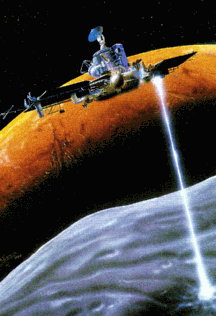|
|
Phobos 1

The Phobos 1 mission was launched on 7 July 1988 from
Baykonur Cosmodrome. The primary objective of the mission, as with its sister
probe Phobos 2, was to explore the larger of Mars' two moons, Phobos. In
addition to instrumentation to explore the Martian satellites, Phobos 1 also
carried instruments to study the Sun, Mars, the interplanetary medium, and
gamma-ray burst sources.
The Phobos 1 spacecraft was lost enroute to Mars after a faulty command
sequence was sent from Earth caused the spacecraft to shut down. The shut down
occurred on 2 September 1988.
Originally, both Phobos spacecraft were to carry identical instrument
payloads. Mass limitations required some tradeoffs so that certain instruments
were carried by only one spacecraft. Phobos 1 carried a total of 25
instruments. Of those, a few were high energy detectors. A diagram of the
Phobos instrumentation is included in the Phobos images page.
- APEX Gamma-ray emission spectrometer.
- LILAS Low-energy gamma-ray burst detector.
- RF-15 X-ray spectrometer.
- VGS High-energy gamma-ray burst detector.
[Gallery]
[Publications]
[All Missions]
[by Time]
[by Energy]
Page authors: Lorella Angelini Jesse Allen
HEASARC Home |
Observatories |
Archive |
Calibration |
Software |
Tools |
Students/Teachers/Public
Last modified: Thursday, 24-Sep-2020 17:37:05 EDT
|


